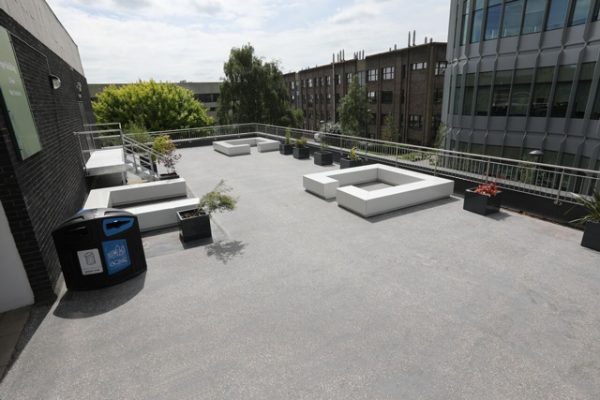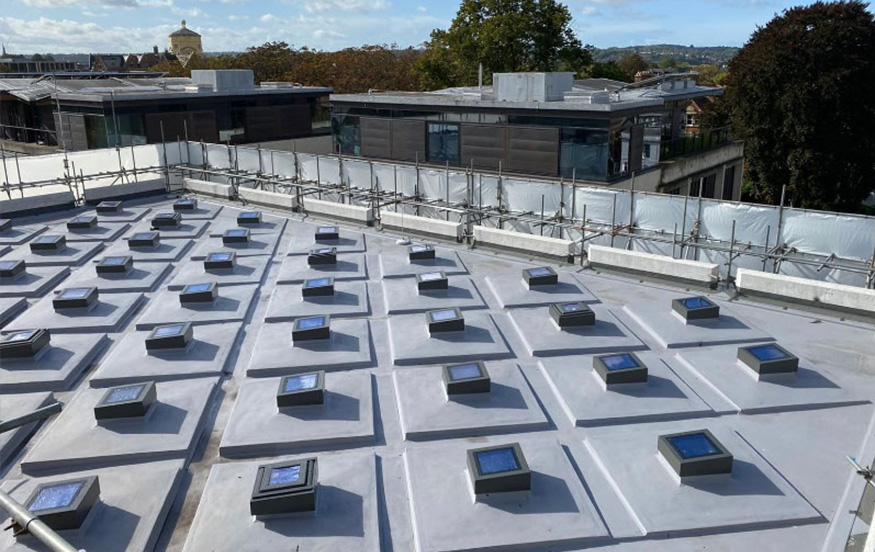Mastic asphalt is an ideal building material for a vast range of construction applications, both new build and refurbishment projects, where a smooth, seamless, durable surface is required. It offers effective waterproofing for roofing and tanking and acts as tough working surface in flooring and paving.
Even though mastic asphalt is one of the world’s most traditional construction materials, having been first patented in 1837, it has continued to develop with the times. Traditionally consisting of graded limestone aggregate bound together with bitumen, today’s mastic asphalt systems are now manufactured using advanced polymer modified formulations to ensure all the performance characteristics of traditional asphalt systems, with the added benefits of increased flexibility, enhanced handling and sustainability.
Mastic asphalt requires skilled application which involves ensuring that asphalt is at the correct temperature, and then spreading it using traditional techniques to coat the surface. A thermoplastic material that changes shape when heated, mastic asphalt cures to form a hard, durable, finished product to suit all applications of mastic asphalt. To maintain the industry’s reputation and ensure high quality applications for every single project, only trained applicators are permitted to install mastic asphalt under the Mastic Asphalt Council’s (MAC) strict rules.
The Building Research Establishment (BRE) has officially stated that asphalt roofing is capable of lasting 50-60 years, but MAC has many examples well in excess of this. For instance, mastic asphalt was first laid at London’s St Paul’s Cathedral in 1906 and it provided well over 100 years’ of effective waterproofing before it needed replacement.
What can mastic asphalt be used for?
 Mastic asphalt is most commonly associated with roofing applications and can be applied to form a continuous waterproof covering over flat, sloped or curved surfaces. It can be worked around pipes, roof lights and other projections to provide a completely seamless membrane. Able to be applied to most types of roof decks including concrete, timber and profile metal, it can also be used on warm roofs, cold roofs and inverted roofs and is manufactured in the UK.
Mastic asphalt is most commonly associated with roofing applications and can be applied to form a continuous waterproof covering over flat, sloped or curved surfaces. It can be worked around pipes, roof lights and other projections to provide a completely seamless membrane. Able to be applied to most types of roof decks including concrete, timber and profile metal, it can also be used on warm roofs, cold roofs and inverted roofs and is manufactured in the UK.
Increasingly MAC contractor members are also installing mastic asphalt paving and finishes to balconies. It offers a hard-wearing surface for car parks, HGV service decks and bridge decks. Durability and versatility make it an ideal covering for areas subjected to regular foot traffic. It can be laid as the surface finish or beneath promenade tiles or paving slabs. Other typical applications include flooring projects, tanking and highway repairs.
The heritage market is a key sector for the industry and mastic asphalt is frequently specified by the National Trust and English Heritage, as well as other public and private owners of prestigious buildings for refurbishment projects. Buckingham Palace is testament to the longevity of mastic asphalt. On top of the Royal household is a rooftop of mastic asphalt that has kept the building dry for well over 80 years. Other heritage applications include the Houses of Parliament, the Tower of London, Tower Bridge, Westminster Cathedral and Edinburgh Castle.
Mastic asphalt screeds
In recent years, there has been an influx of projects where mastic asphalt screeds have been used to provide a stable and cost-effective base for waterproofing applications. Unlike traditional cement screeds which can be slow to cure and labour intensive, there are mastic asphalt screeds on the market that cure rapidly even in inclement weather conditions and can be walked on within just 60 minutes, making them ideal for fast-track projects where other trades are waiting to get to work and the screed needs to be trafficked or overlaid quickly. Mastic asphalt screeds have zero water content, eliminating the time taken for moisture to evaporate in traditional screeds and eradicating the risk of cement stained water penetrating into the underlying structure.
The flexibility and fast curing times of mastic asphalt screeds enable roofing contractors to achieve precise drainage falls quickly and more efficiently, level out uneven substrates and provide a stable base for a specified roofing deck system. Laid at a minimum thickness of 10mm, the screed thickness is up to 80% less than traditional materials, making it much lighter and equally suited for both refurbishment and new build projects.
For full waterproofing protection, mastic asphalt screeds can be overcoated with mastic asphalt roofing systems, as well as other roofing systems such as felt, hot melt roofing, liquid coatings and single ply roofing.
Green Credentials and Sustainability
 Mastic asphalt is well known for being tough, durable and long-lasting, but what is perhaps less well known is that it is one of the most sustainable and greenest building materials currently available.
Mastic asphalt is well known for being tough, durable and long-lasting, but what is perhaps less well known is that it is one of the most sustainable and greenest building materials currently available.
More and more contractors and specifiers are choosing mastic asphalt for a wide range of green roof applications – from schools to hospitals, office buildings to apartment blocks. Whether intensive or extensive, biodiverse or brown, it is critical that green roofs are built on a solid waterproofing foundation.
Recognised for its environmental performance and aesthetic properties, a green roof system laid with a mastic asphalt waterproofing system enhances the environment, controls storm water run-off and reduces noise and heat transmissions by upgrading the acoustic and thermal performance of a roof. When contractors use mastic asphalt for a green roof system, it eliminates the need for root barriers, which may well have been necessary had a substitute material been used.
Mastic asphalt has one further advantage over other types of waterproof membrane – it is carbon neutral – a massive bonus for any building owner anxious to show their green credentials and, when it has reached the end of its useful life, it can be recycled or used as roof screed, minimising the impact on the environment. Over ten years ago the mastic asphalt sector became the first industry in the world to achieve the CarbonZero standard.
This article featured within the February 2022 edition of RCi Magazine – click here to view the article.

